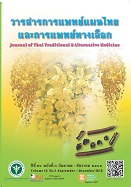Preliminary Survey of Factors Affecting the Decision to Purchase Herbal Products via Social Media among Teenagers and Adolescents in Sai Noi District, Nonthaburi Province
Main Article Content
Abstract
This survey research aimed to explore factors affecting the decision to purchase herbal products via social media among teenagers in Nonthaburi’s Sai Noi district. The study was conducted on a sample of 410 teenagers living in the district with a focus on identifying four groups of factors, including (1) personal factors, (2) social media usage behaviors, (3) social media perceptions, and (4) decisions to purchase herbal products according to the marketing mix theory. Data were collected using a self-administered questionnaire from August through November 2016. The results revealed that most respondents were females aged 12–15, having finished lower secondary education and living with parents. They had a monthly allowance of less than 3,000 baht and used Facebook as a main medium to purchase herbal products from 4 to 8 p.m. Their levels of social media perception and purchasing decisions according to the marketing mix theory were moderate. Thus, it is recommended that consumer health protection agencies and adolescents’ guardians should give proper advice to their dependants about verifying the herbal product information posted on social media before deciding to purchase any of such products. Additionally, relevant authorities should promote the use of valid information regarding herbal product claims posted online. They need to make sure that the herbal products to be bought are neither contaminated nor over-claimed; and the packaging has to bear an FDA-approved registration symbol.
Article Details
References
2. Thai Herbal and Medical Development Group. Conclusion of the seminar on "How to use herbal products is not deceived. 2006 [cited 2016 Aug 10]; Available from: https://www.thaicam.go.th/index.php?option=com_content&view=article&id=149:2009-09-20-14-51-15&catid=71:2009-09-20-11-54-09&Itemid=120 (in Thai)
3. Kaewkangawan S. Psychology of life development for all ages. Theoretical Concept-Middle Childhood, Vol 1. 9nd ed. Bangkok: Thammasat University publisher; 2006. 324 p. (in Thai)
4. Intawan W. Media consumption behavior of adolescents in Chiang Mai (thesis). Chiang Mai: Chiang Mai University; 2010. (in Thai).
5. Voraakom V. 5Insitegeneration C. 2014 [cited 2016 Aug 10]; Available from: https://www.bangkokbiznews.com/blog/detail/591770. (in Thai)
6. Jumnongvej P. What is Gen Y? Should be cut to Gen Y?. 2013 [cited 2016 Aug 24]; Available from: https://www.entraining.net/article-paradorn_gen-y.php (in Thai)
7. Electronic Transactions Development Agency (Public Organization) ETDA Ministry of Information and Communication. Report on Internet user behavior survey in Thailand 2015. 2015 [cited 2016 Aug 10]; Available from: https://www.etda.or.th/documents-for-download.html (in Thai)
8. Sangownwathana P. The study of legitimate advertising of health products situation in regional area. Buletin of the Department of Medical Sciences. [Internet]. 2009 Mar [cited 2016 Aug 10]; 51 (3-4): [204-212screens]. Available from: https://dmsc2.dmsc.moph.go.th/net/ BDMS/data/513420412.pdf (in Thai)
9. Official Statistics Registration Systems. Population and housing statistics annual Report 2015. 2015 [cited 2016 Aug 20]; Available from: https://stat.bora.dopa.go.th/stat/statnew/statTDD/ views/showZoneData.php?rcode=1205&statType=1&year=58 (in Thai)
10. Sirsai S. Applied statistics for social science research. 3rd ed. Bangkok: Faculty of Education, Chulalongkorn University; 2008. 361 p. (in Thai)
11. Serirat S. Consumer Behavior. Bangkok: Development education; 2007. 366 p. (in Thai).
12. Buntadthong K. Social network usage behavior and Bangkok older person’s satisfaction (thesis). Bangkok: Bangkok University; 2014. (in Thai).
13. Klapper J.T. The Effects of Communication. New York: Free Description Press; 1960. 19-25.
14. Prapaipak W. Consumer behavior factors and service marketing mix factors influencing on kitchenware purchase decision making process in amphur muang, Rayong Province (thesis). Bangkok: Bangkok University; 2013. (in Thai).
15. Vanichbuncha K. Statistical analysis: statistics for management. 6th ed. Bangkok: Chulalongkorn University Press. 2002. 550 p. (in Thai).
16. Srisatidnarakul B. The methodology in nursing research. 5th ed. Bangkok: U & I Inter Media Co., Ltd.; 2010. 568 p. (in Thai).
17. Thayreuakom S. Research methodology for social sciences and humanities. 5th ed. Mahasarakham: Mahasarakham University Press. 2012. 289 p. (in Thai).
18. Leechayakittikorn B. Marketing innovation for herb product [Internet]. 2015 [cited 2018 Oct 23]: Available from: https://ethesisarchive.library.tu.ac.th/ thesis/2015/TU_2015_5723030044_3423_ 2120.pdf (in Thai)
19. Chanpool H. Relationship between media exposure andbroadcasting behavior and decision to buy herbalmedicine of chronic disease patients in Koh Tao district,Pa Phayom district. Phatthalung Province (thesis).Nonthaburi: Kanchanabhishek Institute of Medical andPublic Health Technology; 2015 (in Thai)
20. Waicharoen A. Type of advertising on cell phonesinfluencing the buying decision making of consumersin Bangkok. [Internet]. 2014 [cited 2016 Oct 20]; Availablefrom: https://libdoc.dpu.ac.th/research/156602.pdf (inThai)
21. Klapper TJ. Selective exposure theory [Internet]. 2016[cited 2016 Oct 20]: Available from: https://www.bahaistudies.net/asma/selective_exposure-wiki.pdf


